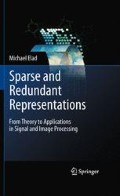Abstract
A fundamental ingredient in the definition of Sparse-Land’s signals and its deployment to applications is the dictionary A. How can we wisely choose A to perform well on the signals in question? This is the topic of this chapter, and our emphasis is put on learning methods for dictionaries, based on a group of examples.
Access this chapter
Tax calculation will be finalised at checkout
Purchases are for personal use only
Preview
Unable to display preview. Download preview PDF.
Further Reading
M. Aharon, M. Elad, and A.M. Bruckstein, K-SVD and its non-negative variant for dictionary design, Proceedings of the SPIE conference wavelets, Vol. 5914, July 2005.
M. Aharon, M. Elad, and A.M. Bruckstein, On the uniqueness of overcomplete dictionaries, and a practical way to retrieve them, Journal of Linear Algebra and Applications, 416(1):48–67, July 2006.
M. Aharon, M. Elad, and A.M. Bruckstein. K-SVD: An algorithm for designing of overcomplete dictionaries for sparse representation, IEEE Trans. on Signal Processing, 54(11):4311–4322, November 2006.
E.J. Candès and D.L. Donoho, Recovering edges in ill-posed inverse problems: optimality of curvelet frames, Annals of Statistics, 30(3):784–842, 2000.
E.J. Candès and D.L. Donoho, New tight frames of curvelets and optimal representations of objects with piecewise-C2 singularities, Comm. Pure Appl. Math., 57:219–266, 2002.
A. Cichocki, R. Zdunek, A.H. Phan, and S.I. Amari, Nonnegative Matrix and Tensor Factorizations Applications to Exploratory Multi-way Data Analysis and Blind Source Separation, Wiley, Tokyo, Japan, 2009.
V. Chandrasekaran, M. Wakin, D. Baron, R. Baraniuk, Surflets: a sparse representation for multidimensional functions containing smooth discontinuities, IEEE Symposium on Information Theory, Chicago, IL, 2004.
R.R. Coifman and M.V. Wickerhauser, Adapted waveform analysis as a tool for modeling, feature extraction, and denoising, Optical Engineering, 33(7):2170–2174, July 1994.
M.N. Do and M. Vetterli, Rotation invariant texture characterization and retrieval using steerable wavelet-domain hidden Markov models, IEEE Trans. On Multimedia, 4(4):517–527, December 2002.
M.N. Do and and M. Vetterli, The finite ridgelet transform for image representation, IEEE Trans. On Image Processing, 12(1):16–28, 2003.
M.N. Do and and M. Vetterli, Framing pyramids, IEEE Trans. On Signal Processing, 51(9):2329–2342, 2003.
M.N. Do and M. Vetterli, The contourlet transform: an efficient directional multiresolution image representation, IEEE Trans. Image on Image Processing, 14(12):2091–2106, 2005.
D.L. Donoho and V. Stodden, When does non-negative matrix factorization give a correct decomposition into parts? Advances in Neural Information Processing 16 (Proc. NIPS 2003), MIT Press, 2004.
M. Elad and M. Aharon, Image denoising via learned dictionaries and sparse representation, International Conference on Computer Vision and pattern Recognition, New-York, June 17–22, 2006.
M. Elad and M. Aharon, Image denoising via sparse and redundant representations over learned dictionaries, IEEE Trans. on Image Processing 15(12):3736–3745, December 2006.
K. Engan, S.O. Aase, and J.H. Husoy, Multi-frame compression: Theory and design, EURASIP Signal Processing, 80(10):2121–2140, 2000.
R. Eslami and H. Radha, The contourlet transform for image de-noising using cycle spinning, in Proceedings of Asilomar Conference on Signals, Systems, and Computers, pp. 1982–1986, November 2003.
R. Eslami and H. Radha, Translation-invariant contourlet transform and its application to image denoising, IEEE Trans. on Image Processing, 15(11):3362–3374, November 2006.
A. Gersho and R.M. Gray, Vector Quantization And Signal Compression, Kluwer Academic Publishers, Dordrecht, Netherlands, 1992.
G.H. Golub and C.F. Van Loan, Matrix Computations, Johns Hopkins Studies in Mathematical Sciences, Third edition, 1996.
P.O. Hoyer, Non-negative matrix factorization with sparseness constraints, Journal of Machine Learning Research, 1457–1469, 2004.
K. Kreutz-Delgado, J.F. Murray, B.D. Rao, K. Engan, T-W, Lee, and T.J. Sejnowski, Dictionary learning algorithms for sparse representation, Neural Computation, 15(2)349–396, 2003.
D. Lee and H. Seung, Learning the parts of objects by non-negative matrix factorization, Nature, 788–791, 1999.
S. Lesage, R. Gribonval, F. Bimbot, and L. Benaroya, Learning unions of orthonormal bases with thresholded singular value decomposition, ICASSP 2005 (IEEE Conf. on Acoustics, Speech and Signal Proc.).
M.S. Lewicki and B.A. Olshausen, A probabilistic framework for the adaptation and comparison of image codes, Journal of the Optical Society of America A: Optics, Image Science and Vision, 16(7):1587–1601, 1999.
M.S. Lewicki and T.J. Sejnowski, Learning overcomplete representations, Neural Computation, 12:337–365, 2000.
Y. Li, A. Cichocki, and S.-i. Amari, Analysis of sparse representation and blind source separation, Neural Computation, 16(6):1193–1234, 2004.
F.G. Meyer, A. Averbuch, and J.O. Stromberg, Fast adaptive wavelet packet image compression, IEEE Trans. on Image Processing, 9(5):792–800, 2000.
F.G. Meyer and R.R. Coifman, Brushlets: a tool for directional image analysis and image compression, Applied and Computational Harmonic Analysis, 4:147–187, 1997.
B.A. Olshausen and D.J. Field, Natural image statistics and efficient coding, Network - Computation in Neural Systems, 7(2):333–339, 1996.
B.A. Olshausen and B.J. Field, Emergence of simple-cell receptive field properties by learning a sparse code for natural images Nature, 381(6583):607–609, 1996.
B.A. Olshausen and B.J. Field, Sparse coding with an overcomplete basis set: A strategy employed by V1? Vision Research, 37(23):3311–3325, 1997.
E.P. Simoncelli, W.T. Freeman, E.H. Adelson, and D.J. Heeger, Shiftable multiscale transforms, IEEE Trans. on Information Theory, 38(2):587–607, 1992.
J.-L. Starck, E.J. Candès, and D.L. Donoho, The curvelet transform for image denoising, IEEE Trans. on Image Processing, 11:670–684, 2002.
Author information
Authors and Affiliations
Corresponding author
Rights and permissions
Copyright information
© 2010 Springer Science+Business Media, LLC
About this chapter
Cite this chapter
Elad, M. (2010). The Quest for a Dictionary. In: Sparse and Redundant Representations. Springer, New York, NY. https://doi.org/10.1007/978-1-4419-7011-4_12
Download citation
DOI: https://doi.org/10.1007/978-1-4419-7011-4_12
Published:
Publisher Name: Springer, New York, NY
Print ISBN: 978-1-4419-7010-7
Online ISBN: 978-1-4419-7011-4
eBook Packages: Mathematics and StatisticsMathematics and Statistics (R0)

